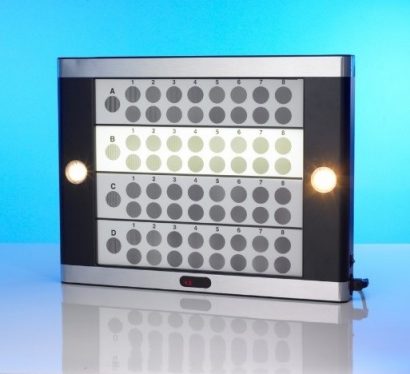Contrast Sensitivity – A Curve for Vision
Written by Dr. David Evans Last modified on August 6, 2018

Considerable confusion persists among consumers as to what 20/20 vision really means. I wrote a post on this question last year. To further this confusion, 20/20 is really only one number, whereas vision is much more than one number. Acuity — using the black on white chart — measures how people see only under very high contrast conditions. It fails to measure how people see in the real-world, which includes a wide range of contrast levels. A relatively new test, called contrast sensitivity, is now starting to be used more in clinical practice.
I personally became familiar with contrast sensitivity testing about 30 years ago when I was in the military. The Air Force was interested in why some pilots with 20/20 acuity could detect an enemy aircraft at much greater distances than other pilots who also had 20/20. The Air Force wanted to know if other tests were better. We published a number of studies that showed that contrast sensitivity — which measures how people see various size objects under different contrast conditions — is a better predictor of how pilots see in the real world. I published the first paper showing that contrast sensitivity is a better predictor of nighttime driver performance than the Big E-Chart. Subsequently, a number of researchers and clinicians have discovered that contrast sensitivity is very useful for evaluating eye disease and general eye health. In fact, now the FDA requires contrast sensitivity to be used to evaluate patient outcomes provided by new types of refractive lasers and lenses (only surgical procedures, not contact lenses). The patient results for all of the lasers approved by the FDA have been tested by contrast sensitivity.
The test is pretty straightforward. The patient is asked to look at a bar pattern at different contrast levels. The contrast level at which the patient can just barely detect the bar pattern is the patient’s contrast sensitivity. When a series of different size bar patterns is used, the contrast sensitivity is determined for each bar, and a curve results. The attached picture shows a typical curve and the limited range tested by high contrast 20/20 acuity. The higher the curve, the better the contrast sensitivity.
The test can also be conducted with low contrast letters or symbols. And, some doctors add glare to contrast sensitivity to determine how well patients see in bright sunlight or with glare due to oncoming headlights. This combination testing is particularly useful for determining how cataract patients see in the real world, because they can often have good high contrast vision, E-chart vision, but not be able to see well in low contrast settings, particularly glare conditions. (Incidentally, the FDA now requires this combination testing to evaluate new refractive technologies.) The picture on the right shows a test with the glare lights on. You should be able to see a few of the low contrast bar patterns on each row.
